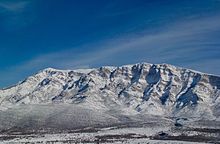Dinara
This article needs additional citations for verification. (September 2011) |
| Dinara | |
|---|---|
Country high point | |
| Coordinates | 43°56′42″N 16°35′49″E / 43.9450943°N 16.59693°E |
| Geography | |
| Location | Bosnia and Herzegovina / Croatia |
| Parent range | Dinaric Alps |
Dinara is a 100-kilometre-long (60-mile) mountain range in the Dinaric Alps, located on the border of Bosnia and Herzegovina and Croatia. It has four major mountains or peaks, from north-west to south-east:[1]
- Ilica or Ujilica (1654 m)
- Sinjal or Dinara (1831 m), eponym to the range, highest mountain in Croatia
- Troglav (1913 m), highest peak in the range
- Kamešnica, with peak Konj (1855 m)[2]
Note the dual use of the name Dinara, which is also the origin of the name for the whole Dinaric Alps.[3] The range is composed of limestone and dolomite.[4]
Etymology
The origin of the name is uncertain. It may deliver from a forgotten Illyrian tribe name, or it is named after a settlement in or near the region.[5] According to Šišić, the Dinara name resembles the name of the Dindari, an Illyrian tribe that inhabited the western bank of the Drina Valley.[6]


Dinara Mountain
Sinjal, often marked as Dinara on maps, is the highest mountain in
Climate
Dinara is located only a few dozen kilometers away from the
There are no inhabited areas on the mountain itself and human presence consists mostly of small shacks that belong to the herdsmen from the nearby valleys such as that of the Cetina river.
Tourism
One of the most fascinating massifs is on the southwestern slope. It is six kilometers long and up to 1700 meters high, providing an interesting landscape for the travelers on the roads in the valley below to view. The massif does not attract many climbers, but its Ošljak peak (1706 m) does.
Flora and fauna
Flora
Native vegetation of the Dinara region comprises a large number of plant communities, or habitat types. According to the data available, in the area of the Dinara mountain there are around 750 plant species, of which more than 110 are strictly protected and 55 are endemics.
The flora consists of mountain grasslands, Scopoli's rockcress (
Fauna
Birds
The Dinara region, particularly Dinara itself and the habitat around the Upper Cetina, from its source to the Peruća dam, is designated as a Special Protection Area (SPA) by the EU Directive on the Conservation of Wild Birds.
The bird species include: common pheasant
Mammals
The mammals of the Dinara region are: brown bear
Insects
The relatively well-preserved, extensive and diverse habitats of the Dinara and Svilaja mountains and the Upper Cetina provide a refuge to a number of invertebrate species whose natural habitats have been endangered due to specific living conditions they require, while many of them are endemics and placed on the Red List (certain species of caddisflies, dragonflies, stoneflies, orthoptera, etc.).
Invertebrates living in caves and holes make a special group – their biology remains relatively unknown, but they are protected as the cave fauna together with cave vertebrates.
Insects include: dalmatian ringlet Proterebia afra dalmata, rosalia longicorn, longhorn beetle, firebug, hornet, bumblebee, stag beetle and marsh fritillary.
Herpetology
The herpetofauna of the Dinara region comprises around 15 species of lizards, snakes and amphibians, some of which are endangered, mostly due to the fact that their natural habitats have been either reduced in extent or suffered degradation.
The herpetofauna comprises: smooth snake, balkan whip snake, nose-horned viper, fire salamander, slow worm, karst meadow viper and alpine newt.
Gallery



See also
Citations
- ^ Tvrtković, Šašić; Mihoci, Marijana; Vuković, Maja (2012). "Review of the butterfly fauna (Hesperioidea & Papilionoidea) of the Dinara mountain range". Natura Croatica. Retrieved 2020-07-19.
- ISSN 1333-3305. Retrieved 27 December 2015.
- ^ Statistical Yearbook of the Republic of Croatia 2015, p. 48
- ^ Tvrtković, Šašić; Mihoci, Marijana; Vuković, Maja (2012). "Review of the butterfly fauna (Hesperioidea & Papilionoidea) of the Dinara mountain range". Natura Croatica. Retrieved 2020-07-19.
- OCLC 1124474803.)
{{cite book}}: CS1 maint: location missing publisher (link - ISBN 953-214-196-0.
- ^ "Dinara" on Peakbagger.com Retrieved 1 October 2011
- ^ Geography of Croatia on Europeaklist Gives a topographic prominence of 728 based on an elevation of 1,831 m. Retrieved 1 October 2011
- ^ Dinara, the highest mountain of Croatia
- ^ Statistical Yearbook of the Republic of Croatia 2015, p. 42
- ^ Statistical Yearbook of the Republic of Croatia 2015, p. 43
General sources
- Ostroški, Ljiljana, ed. (December 2015). Statistički ljetopis Republike Hrvatske 2015 [Statistical Yearbook of the Republic of Croatia 2015] (PDF). Statistical Yearbook of the Republic of Croatia (in Croatian and English). Vol. 47. Zagreb: ISSN 1333-3305. Retrieved 27 December 2015.

